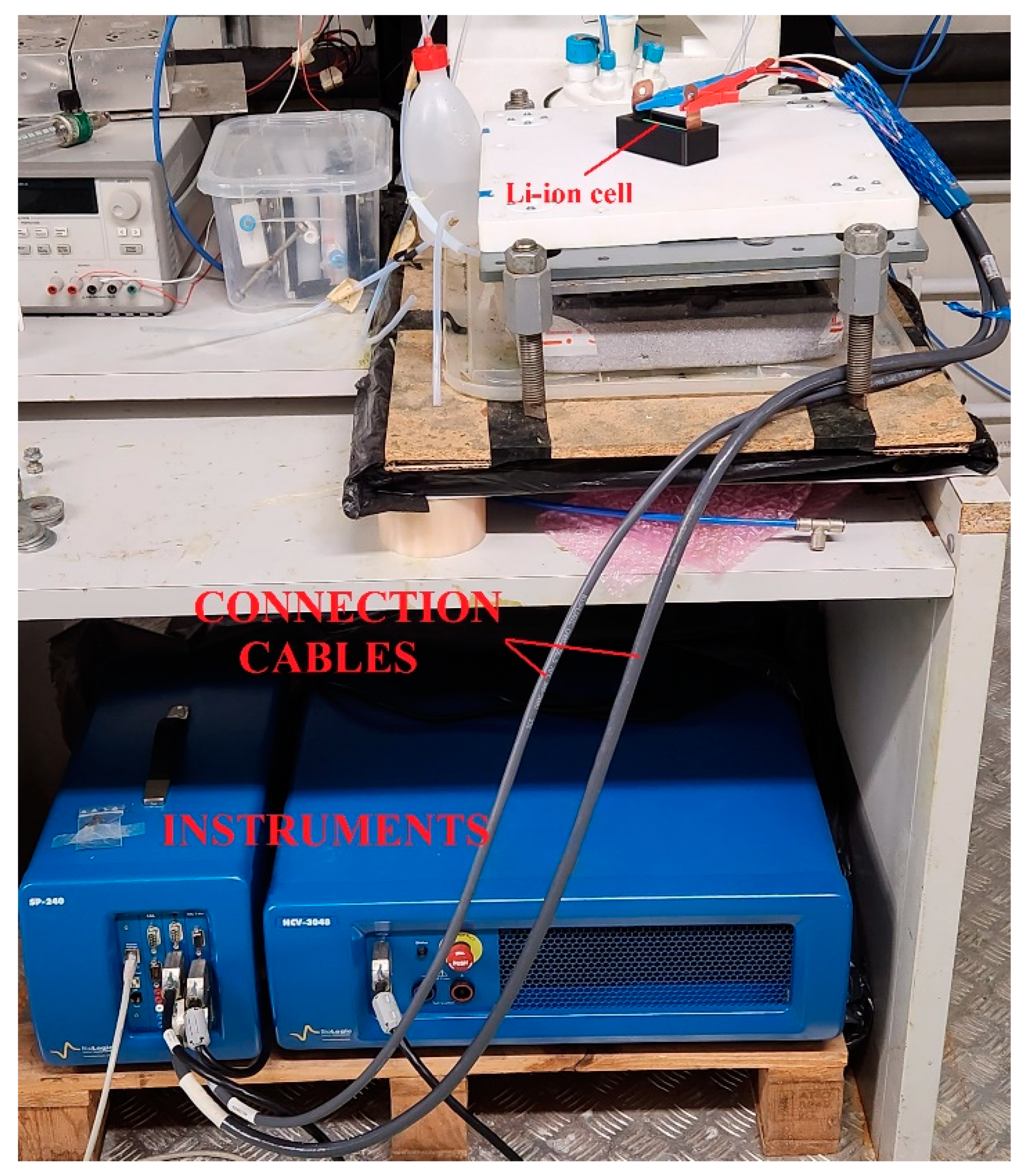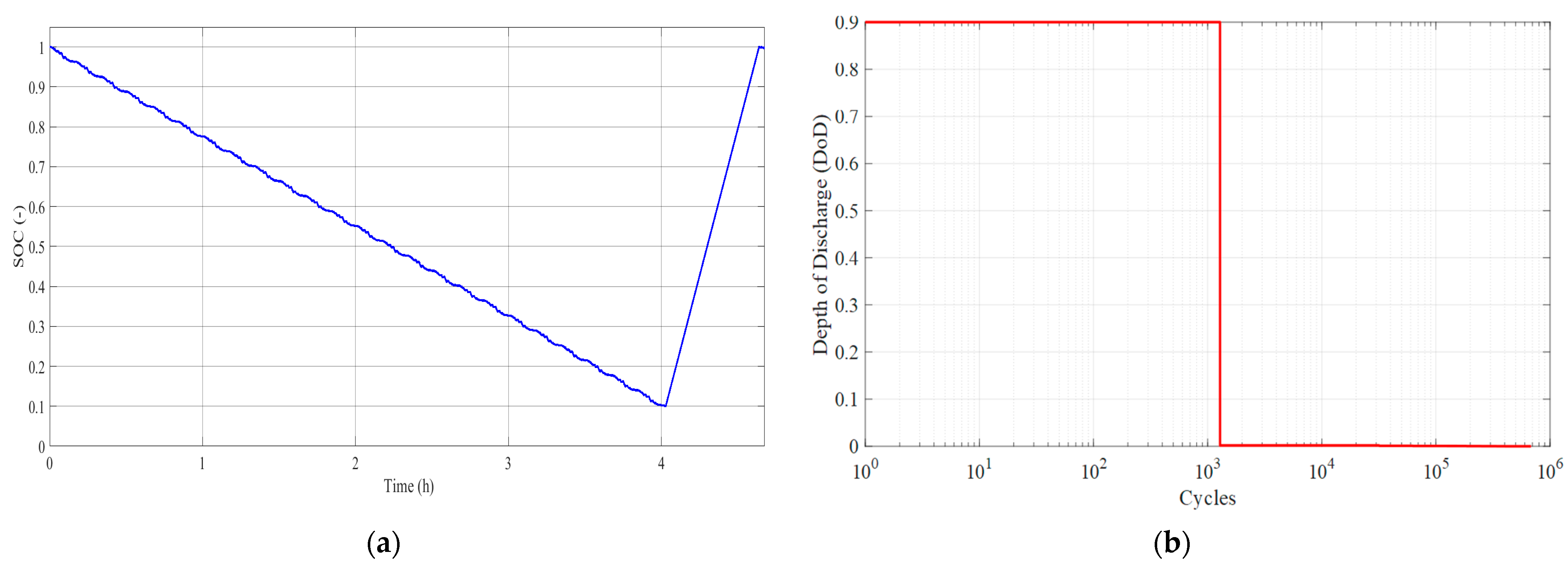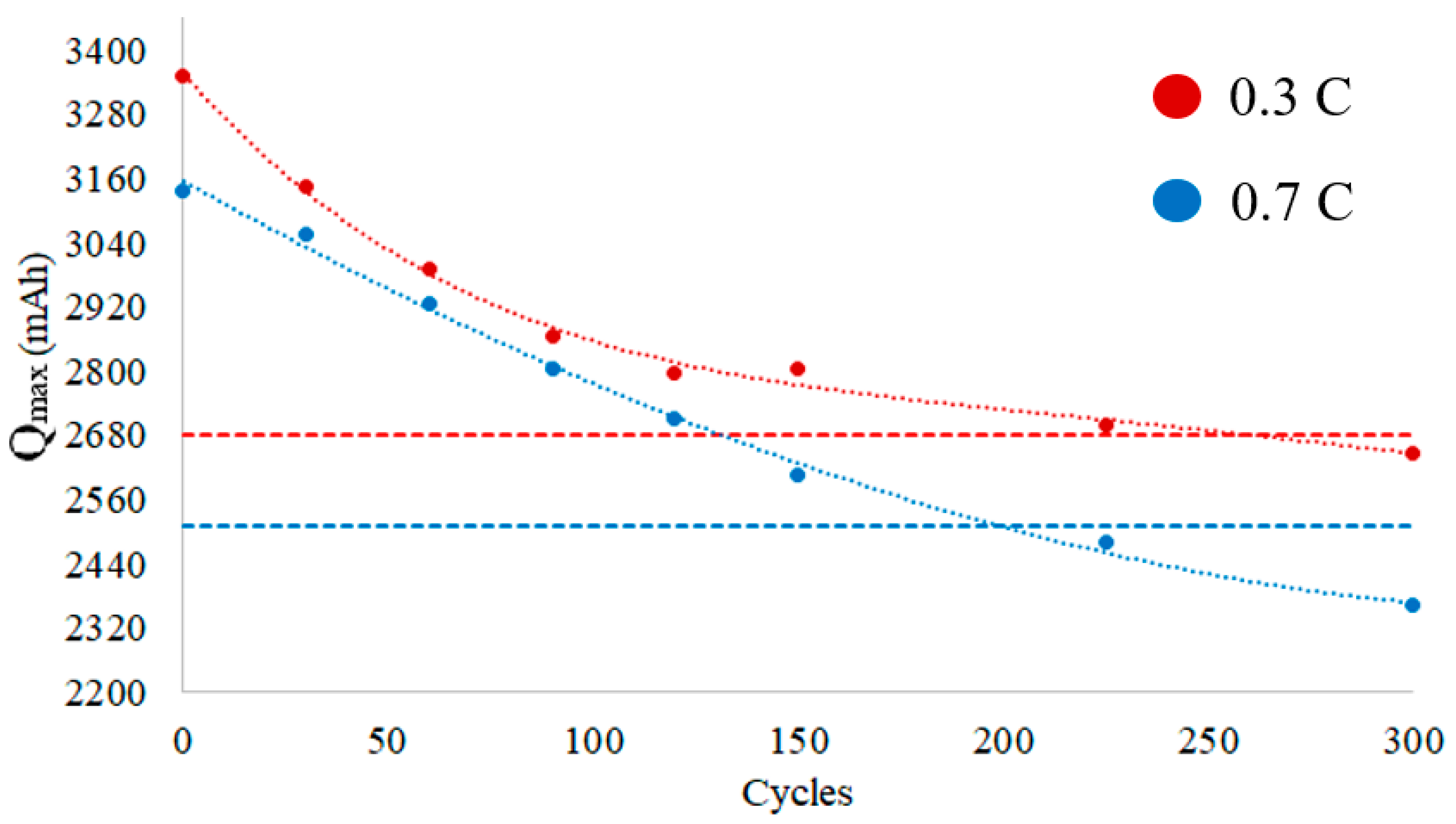Experimental Investigation of Fast−Charging Effect on Aging of Electric Vehicle Li−Ion Batteries
Abstract
:1. Introduction
2. Battery Degradation Theory
2.1. Aging Phenomena
2.2. Rainflow Cycle Counting
- Count the number of half−cycles by looking for terminations in the flow occurring when either:
- It reaches the end of the time history;
- It merges with a flow that started at an earlier reversal;
- It encounters a trough of greater magnitude.
- Assign a magnitude to each half−cycle corresponding to the stress difference between its start and termination.
- Pair up half−cycles of equal magnitude (but in opposite sense) to count the number of complete cycles. Generally, some residual half−cycles are present. Concerning Li−ion batteries, the most relevant cycles for degradation are those with more than 2% DoD [50]. Hence, the cycles at a lower DoD are not considered in this work. Figure 1 shows an example of RFC operation on a generic load time history.
- The first and second points are collectively called Y;
- The second and third points are collectively called X;
- In both X and Y, the points are sorted from earlier to later in time, although not necessarily consecutive;
- The range of X, denoted by r(X), corresponds to the absolute value of the difference between the amplitude of the first point and the amplitude of the second point. The range r(Y) is equally defined.
2.3. Battery State of Health
3. Dynamic Modeling
3.1. Input Data
3.2. Battery Modeling Description
4. Experimental Activity: Materials and Methods
4.1. Aging Test Design
- Initial Battery Capacity Determination (BCD).
- Galvanostatic charge/discharge cycling was repeated 30 times up to 150 cycles and subsequently repeated 75 times up to 300 cycles. Every 30 cycles (until the battery reaches 150 cycles), BCD was performed to assess the capacity fade due to cycle aging. Subsequently, when the cell exceeded 150 cycles, BCD was carried out every 75 aging cycles until the battery reached the maximum number of aging cycles allowed by the manufacturer. The restricted cycling range of up to 150 cycles was chosen since the first aging cycles did not follow a linear relation with capacity fading.
4.2. Experimental Section
5. Results and Discussion
5.1. Simulation and Rainflow Cycle Counting
5.2. Experimental Results
6. Conclusions
- A dynamic battery model was developed to obtain the SoC variation over the considered driving cycle.
- A customized rainflow cycle counting algorithm was applied to the SoC profile to identify the DoD of each cycle for subsequent implementation on the experimental test rig.
- Galvanostatic charge/discharge cycling interspersed by battery capacity determination was carried out for two NCR cells, emulating the BEV charge at 22 kW and 50 kW, respectively.
- The experimentally obtained results are in line with the aging performed by the manufacturer.
- A battery lifespan reduction of about 17% is registered when the cell is discharged at a higher C−rate (i.e., 0.7C with respect to 0.3C).
Author Contributions
Funding
Data Availability Statement
Conflicts of Interest
References
- Statista. EU−27: GHG Emissions by Sector 1990–2020. Available online: https://www.statista.com/statistics/1171183/ghg−emissions−sector−european−union−eu/ (accessed on 11 October 2022).
- Statista. Carbon Dioxide Emissions from Road Transportation in the European Union from 1990 to 2019, by Transport Mode. Available online: https://www.statista.com/statistics/1236763/road−transportation−greenhouse−gas−emissions−eu−by−mode/ (accessed on 11 October 2022).
- Plötz, P. Hydrogen Technology Is Unlikely to Play a Major Role in Sustainable Road Transport. Nat. Electron. 2022, 5, 8–10. [Google Scholar] [CrossRef]
- Pelosi, D.; Longo, M.; Bidini, G.; Zaninelli, D.; Barelli, L. A new concept of highways infrastructure integrating energy storage devices for e-mobility transition. J. Energy Storage 2023, 65, 107364. [Google Scholar] [CrossRef]
- Saldarini, A.; Barelli, L.; Pelosi, D.; Miraftabzadeh, S.; Longo, M.; Yaici, W. Different Demand for Charging Infrastructure along a Stretch of Highway: Italian Case Study. In Proceedings of the 2022 IEEE International Conference on Environment and Electrical Engineering and 2022 IEEE Industrial and Commercial Power Systems Europe (EEEIC/I&CPS Europe), Prague, Czech Republic, 28 June–1 July 2022. [Google Scholar]
- Barelli, L.; Longo, M.; Ottaviano, P.A.; Pelosi, D.; Zaninelli, D.; Gallorini, F. Vanadium Redox Flow Battery in Hybrid Propulsion Systems for Marine Applications. In Proceedings of the 2022 IEEE 21st Mediterranean Electrotechnical Conference (MELECON), Palermo, Italy, 14–16 June 2022; pp. 58–62. [Google Scholar]
- Barelli, L.; Bidini, G.; Gallorini, F.; Ottaviano, P.A.; Pelosi, D.; Perla, M.; Serangeli, M. Oxygen reduction approaches for fire protection to increase grid Li−ion BESS safety. E3S Web Conf. 2021, 238, 09001. [Google Scholar] [CrossRef]
- Shafiei, M.; Ghasemi-Marzbali, A. Fast-charging station for electric vehicles, challenges and issues: A comprehensive review. J. Energy Storage 2022, 49, 104136. [Google Scholar] [CrossRef]
- Lin, X.; Hao, X.; Liu, Z.; Jia, W. Health conscious fast charging of Li−ion batteries via a single particle model with aging mechanisms. J. Power Sources 2018, 400, 305–316. [Google Scholar] [CrossRef]
- Gnann, T.; Funke, S.; Jakobsson, N.; Plötz, P.; Sprei, F.; Bennehag, A. Fast Charging Infrastructure for Electric Vehicles: Today’s Situation and Future Needs. Transp. Res. Part D Transp. Environ. 2018, 62, 314–329. [Google Scholar] [CrossRef]
- Funke, S.A.; Plötz, P. A techno−economic analysis of fast charging needs in Germany for different ranges of battery electric vehicles. In Proceedings of the European Electric Vehicle Congress (EEVC), Geneva, Switzerland, 14–16 March 2017. [Google Scholar]
- Bose, B.; Garg, A.; Panigrahi, B.K.; Kim, J. Study on Li−Ion Battery Fast Charging Strategies: Review, Challenges and Proposed Charging Framework. J. Energy Storage 2022, 55, 05507. [Google Scholar] [CrossRef]
- ACEA. Alternative Fuels Infrastructure Regulation Cars & Vans. Available online: https://www.acea.auto/fact/fact−sheet−alternative−fuels−infrastructure−regulation−cars−vans/ (accessed on 21 July 2023).
- He, H.; Sun, F.; Wang, Z.; Lin, C.; Zhang, C.; Xiong, R.; Deng, J.; Zhu, X.; Xie, P.; Zhang, S.; et al. China’s battery electric vehicles lead the world: Achievements in technology system architecture and technological breakthroughs. Green Energy Intell. Transp. 2022, 1, 100020. [Google Scholar] [CrossRef]
- Carmeli, M.S.; Toscani, N.; Mauri, M. Electrothermal Aging Model of Li−Ion Batteries for Vehicle−to−Grid Services Evaluation. Electronics 2022, 11, 1042. [Google Scholar] [CrossRef]
- Zhou, L.; Zhao, Y.; Li, D.; Wang, Z. State−of−Health Estimation for LiFePO4 Battery System on Real−World Electric Vehicles Considering Aging Stage. IEEE Trans. Transp. Electrif. 2022, 8, 1724–1733. [Google Scholar] [CrossRef]
- Mesbahi, T.; Rizoug, N.; Bartholomëus, P.; Sadoun, R.; Khenfri, F.; Le Moigne, P. Dynamic Model of Li−Ion Batteries Incorporating Electrothermal and Ageing Aspects for Electric Vehicle Applications. IEEE Trans. Ind. Electron. 2018, 65, 1298–1305. [Google Scholar] [CrossRef]
- Liu, K.; Zou, C.; Li, K.; Wik, T. Charging Pattern Optimization for Lithium−Ion Batteries with an Electrothermal−Aging Model. IEEE Trans. Ind. Inform. 2018, 14, 5463–5474. [Google Scholar] [CrossRef]
- Jafari, M.; Khan, K.; Gauchia, L. Deterministic Models of Li−Ion Battery Aging: It Is a Matter of Scale. J. Energy Storage 2018, 20, 67–77. [Google Scholar] [CrossRef]
- Barcellona, S.; Brenna, M.; Foiadelli, F.; Longo, M.; Piegari, L. Battery Lifetime for Different Driving Cycles of EVs. In Proceedings of the 2015 IEEE 1st International Forum on Research and Technologies for Society and Industry Leveraging a Better tomorrow (RTSI), Turin, Italy, 16–18 September 2015; pp. 6–10. [Google Scholar]
- Scarfogliero, M.; Carmeli, S.; Castelli-Dezza, F.; Mauri, M.; Rossi, M.; Marchegiani, G.; Rovelli, E. Lithium-Ion Batteries for Electric Vehicles: A Review on Aging Models for Vehicle-to-Grid Services. In Proceedings of the 2018 International Conference of Electrical and Electronic Technologies for Automotive, Milan, Italy, 9–11 July 2018. [Google Scholar] [CrossRef]
- Zhou, Z.; Liu, Y.; You, M.; Xiong, R.; Zhou, X. Green Energy and Intelligent Transportation Two-stage aging trajectory prediction of LFP lithium−ion battery based on transfer learning with the cycle life prediction. Green Energy Intell. Transp. 2022, 1, 100008. [Google Scholar] [CrossRef]
- Vermeer, W.; Chandra Mouli, G.R.; Bauer, P. A Comprehensive Review on the Characteristics and Modeling of Lithium−Ion Battery Aging. IEEE Trans. Transp. Electrif. 2022, 8, 2205–2232. [Google Scholar] [CrossRef]
- Bavand, A.; Khajehoddin, S.A.; Ardakani, M.; Tabesh, A. Online Estimations of Li−Ion Battery SOC and SOH Applicable to Partial Charge/Discharge. IEEE Trans. Transp. Electrif. 2022, 8, 3673–3685. [Google Scholar] [CrossRef]
- Guha, A.; Patra, A. State of Health Estimation of Lithium−Ion Batteries Using Capacity Fade and Internal Resistance Growth Models. IEEE Trans. Transp. Electrif. 2017, 4, 135–146. [Google Scholar] [CrossRef]
- Hu, X.; Che, Y.; Lin, X.; Onori, S. Battery Health Prediction Using Fusion-Based Feature Selection and Machine Learning. IEEE Trans. Transp. Electrif. 2021, 7, 382–398. [Google Scholar] [CrossRef]
- Chen, L.; Ding, Y.; Wang, H.; Wang, Y.; Liu, B.; Wu, S.; Li, H.; Pan, H. Online Estimating State of Health of Lithium−Ion Batteries Using Hierarchical Extreme Learning Machine. IEEE Trans. Transp. Electrif. 2022, 8, 965–975. [Google Scholar] [CrossRef]
- Yang, J.; Cai, Y.; Mi, C.C. State-of-Health Estimation for Lithium−Ion Batteries Based on Decoupled Dynamic Characteristic of Constant-Voltage Charging Current. IEEE Trans. Transp. Electrif. 2022, 8, 2070–2079. [Google Scholar] [CrossRef]
- Anselma, P.G.; Kollmeyer, P.J.; Feraco, S.; Bonfitto, A.; Belingardi, G.; Emadi, A.; Amati, N.; Tonoli, A. Economic Payback Time of Battery Pack Replacement for Hybrid and Plug-in Hybrid Electric Vehicles. IEEE Trans. Transp. Electrif. 2022, 1, 1021–1033. [Google Scholar] [CrossRef]
- Xu, B.; Oudalov, A.; Ulbig, A.; Andersson, G.; Kirschen, D.S. Modeling of Lithium−Ion Battery Degradation for Cell Life Assessment. IEEE Trans. Smart Grid 2018, 9, 1131–1140. [Google Scholar] [CrossRef]
- Vetter, J.; Novák, P.; Wagner, M.R.; Veit, C.; Möller, K.C.; Besenhard, J.O.; Winter, M.; Wohlfahrt-Mehrens, M.; Vogler, C.; Hammouche, A. Ageing Mechanisms in Lithium−Ion Batteries. J. Power Sources 2005, 147, 269–281. [Google Scholar] [CrossRef]
- Laresgoiti, I.; Käbitz, S.; Ecker, M.; Sauer, D.U. Modeling Mechanical Degradation in Lithium Ion Batteries during Cycling: Solid Electrolyte Interphase Fracture. J. Power Sources 2015, 300, 112–122. [Google Scholar] [CrossRef]
- Wang, J.; Liu, P.; Hicks−Garner, J.; Sherman, E.; Soukiazian, S.; Verbrugge, M.; Tataria, H.; Musser, J.; Finamore, P. Cycle-Life Model for Graphite-LiFePO4 Cells. J. Power Sources 2011, 196, 3942–3948. [Google Scholar] [CrossRef]
- Kassem, M.; Bernard, J.; Revel, R.; Pélissier, S.; Duclaud, F.; Delacourt, C. Calendar Aging of a Graphite/LiFePO4 Cell. J. Power Sources 2012, 208, 296–305. [Google Scholar] [CrossRef]
- Miner, M.A. Cumulative Damage in Fatigue. J. Appl. Mech. 1945, 12, A159–A164. [Google Scholar] [CrossRef]
- Tankari, M.A.; Camara, M.B.; Dakyo, B.; Lefebvre, G. Use of Ultracapacitors and Batteries for Efficient Energy Management in Wind-Diesel Hybrid System. IEEE Trans. Sustain. Energy 2013, 4, 414–424. [Google Scholar] [CrossRef]
- Zubi, G.; Dufo-López, R.; Pasaoglu, G.; Pardo, N. Techno-Economic Assessment of an off-Grid PV System for Developing Regions to Provide Electricity for Basic Domestic Needs: A 2020–2040 Scenario. Appl. Energy 2016, 176, 309–319. [Google Scholar] [CrossRef]
- Shi, Y.; Xu, B.; Tan, Y.; Kirschen, D.; Zhang, B. Optimal Battery Control under Cycle Aging Mechanisms in Pay for Performance Settings. IEEE Trans. Autom. Control 2019, 64, 2324–2339. [Google Scholar] [CrossRef]
- De la Parra, I.; Marcos, J.; García, M.; Marroyo, L. Improvement of a Control Strategy for PV Power Ramp-Rate Limitation Using the Inverters: Reduction of the Associated Energy Losses. Sol. Energy 2016, 127, 262–268. [Google Scholar] [CrossRef]
- Belouda, M.; Jaafar, A.; Sareni, B.; Roboam, X.; Belhadj, J. Integrated Optimal Design and Sensitivity Analysis of a Stand Alone Wind Turbine System with Storage for Rural Electrification. Renew. Sustain. Energy Rev. 2013, 28, 616–624. [Google Scholar] [CrossRef]
- Gee, A.M.; Robinson, F.V.P.; Dunn, R.W. Analysis of Battery Lifetime Extension in a Small-Scale Wind-Energy System Using Supercapacitors. IEEE Trans. Energy Convers. 2013, 28, 24–33. [Google Scholar] [CrossRef]
- Mandelli, S.; Brivio, C.; Colombo, E.; Merlo, M. Effect of Load Profile Uncertainty on the Optimum Sizing of Off-Grid PV Systems for Rural Electrification. Sustain. Energy Technol. Assess. 2016, 18, 34–47. [Google Scholar] [CrossRef]
- Barelli, L.; Bidini, G.; Cherubini, P.; Micangeli, A.; Pelosi, D.; Tacconelli, C. How Hybridization of Energy Storage Technologies Can Provide Additional Flexibility and Competitiveness to Microgrids in the Context of Developing Countries. Energies 2019, 12, 3138. [Google Scholar] [CrossRef]
- Barelli, L.; Bidini, G.; Bonucci, F.; Castellini, L.; Fratini, A.; Gallorini, F.; Zuccari, A. Flywheel Hybridization to Improve Battery Life in Energy Storage Systems Coupled to RES Plants. Energy 2019, 173, 937–950. [Google Scholar] [CrossRef]
- Barelli, L.; Bidini, G.; Ciupageanu, D.A.; Pelosi, D. Integrating Hybrid Energy Storage System on a Wind Generator to Enhance Grid Safety and Stability: A Levelized Cost of Electricity Analysis. J. Energy Storage 2021, 34, 102050. [Google Scholar] [CrossRef]
- Barelli, L.; Bidini, G.; Ottaviano, P.A.A.; Pelosi, D. Vanadium Redox Flow Batteries Application to Electric Buses Propulsion: Performance Analysis of Hybrid Energy Storage System. J. Energy Storage 2019, 24, 100770. [Google Scholar] [CrossRef]
- MathWorks Italia. Rainflow Counts for Fatigue Analysis—MATLAB Rainflow. Available online: https://it.mathworks.com/help/signal/ref/rainflow.html#d123e146736 (accessed on 6 October 2022).
- Huang, J.; Wang, S.; Xu, W.; Fernandez, C.; Fan, Y.; Chen, X. An Improved Rainflow Algorithm Combined with Linear Criterion for the Accurate Li−Ion Battery Residual Life Prediction. Int. J. Electrochem. Sci. 2021, 16, 21075. [Google Scholar] [CrossRef]
- Irvine, T. Rainflow Cycle Counting in Fatigue Analysis. Available online: https://citeseerx.ist.psu.edu/document?repid=rep1&type=pdf&doi=e8663ef9235a09845b0eb065531b036ee207c89b (accessed on 21 July 2023).
- Mayordomo, I. Adaptative Estimation of Lithium−Ion Battery Degradation in Primary Frequency Response. Available online: https://upcommons.upc.edu/handle/2117/332792 (accessed on 21 July 2023).
- Hossain, E.; Murtaugh, D.; Mody, J.; Faruque, H.M.R.; Sunny, M.S.H.; Mohammad, N. A Comprehensive Review on Second-Life Batteries: Current State, Manufacturing Considerations, Applications, Impacts, Barriers Potential Solutions, Business Strategies, and Policies. IEEE Access 2019, 7, 73215–73252. [Google Scholar] [CrossRef]
- Barelli, L.; Bidini, G.; Bonucci, F.; Castellini, L.; Castellini, S.; Ottaviano, A.; Pelosi, D.; Zuccari, A. Dynamic Analysis of a Hybrid Energy Storage System (H−ESS) Coupled to a Photovoltaic (PV) Plant. Energies 2018, 11, 396. [Google Scholar] [CrossRef]
- Scheda Tecnica 1436402 Panasonic NCR18650B Batteria Ricaricabile Speciale 18650 Li−Ion 3.7 V 3400 mAh. Available online: https://www.conrad.it/it/p/panasonic−ncr18650b−batteria−ricaricabile−speciale−18650−li−ion−3−7−v−3400−mah−1436402.html#productDownloads (accessed on 21 July 2023).









| Parameter | Value |
|---|---|
| Nominal voltage | 3.6 V |
| Nominal capacity (at 25 °C) | 3350 mAh (typical) |
| Weight | 47.5 g |
| Max discharge C−rate | 2C |
| Max charge C−rate | 0.7C |
| Voltage operating range | 2.5 V–4.2 V |
Disclaimer/Publisher’s Note: The statements, opinions and data contained in all publications are solely those of the individual author(s) and contributor(s) and not of MDPI and/or the editor(s). MDPI and/or the editor(s) disclaim responsibility for any injury to people or property resulting from any ideas, methods, instructions or products referred to in the content. |
© 2023 by the authors. Licensee MDPI, Basel, Switzerland. This article is an open access article distributed under the terms and conditions of the Creative Commons Attribution (CC BY) license (https://creativecommons.org/licenses/by/4.0/).
Share and Cite
Pelosi, D.; Longo, M.; Zaninelli, D.; Barelli, L. Experimental Investigation of Fast−Charging Effect on Aging of Electric Vehicle Li−Ion Batteries. Energies 2023, 16, 6673. https://doi.org/10.3390/en16186673
Pelosi D, Longo M, Zaninelli D, Barelli L. Experimental Investigation of Fast−Charging Effect on Aging of Electric Vehicle Li−Ion Batteries. Energies. 2023; 16(18):6673. https://doi.org/10.3390/en16186673
Chicago/Turabian StylePelosi, Dario, Michela Longo, Dario Zaninelli, and Linda Barelli. 2023. "Experimental Investigation of Fast−Charging Effect on Aging of Electric Vehicle Li−Ion Batteries" Energies 16, no. 18: 6673. https://doi.org/10.3390/en16186673
APA StylePelosi, D., Longo, M., Zaninelli, D., & Barelli, L. (2023). Experimental Investigation of Fast−Charging Effect on Aging of Electric Vehicle Li−Ion Batteries. Energies, 16(18), 6673. https://doi.org/10.3390/en16186673









